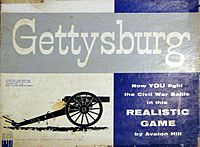Gettysburg (game) facts for kids
|
Gettysburg (1958) by Avalon Hill
|
|
| Players | 2 |
|---|---|
| Setup time | 15 minutes |
| Playing time | 4 to 6 hours |
| Random chance | Medium |
| Skill(s) required | Tactics, strategy |
Gettysburg is a classic board wargame made by Avalon Hill. It lets players re-create the famous American Civil War Battle of Gettysburg. This game was one of the first of its kind. It helped shape how many war-themed board games are designed today.
Contents
Game History
The First Modern Wargame
The game Gettysburg first came out in 1958. It was the very first board wargame based on a real historical battle. This made it a very important game in history.
Gettysburg shares some game mechanics with another early Avalon Hill game called Tactics II. For example, in both games, attacking with more units gives you a better chance to win. But Gettysburg added new ideas. Your units could face different directions. Attacking an enemy from the side or behind gave you an advantage. Also, defending on a hill made your units stronger.
A Quote from the Creator
Charles S. Roberts, who started Avalon Hill, talked about Gettysburg in 1983. He said:
Gettysburg was chosen as a topic because the Civil War Centennial was coming up. This was a smart choice because the celebration was very popular. Gettysburg was special because it was the first modern historical wargame. It was also the only wargame introduced without any testing. This caused problems through many redesigns. However, it sold very well and was a successful game despite its flaws.
How the Game Changed Over Time
The first version of Gettysburg in 1958 felt a bit like a miniatures game. The game board had a square grid. But this grid was mainly for tracking hidden moves. Units moved using special "range cards." These cards also helped check how far units could shoot. Units could turn before using their range cards. Attacking an enemy's side gave you a bonus.
In 1961, the game was updated. It started using a hex grid. This type of grid became very popular in wargames. It made moving units much easier to understand. Even though it was popular, Avalon Hill went back to a square grid for the 1964 edition.
The hex grid returned in the 1977 version. This edition also had more complex rules. It tried to show how units moved in columns. It also showed how hard it was to change them into a battle line. This version had separate pieces for unit flanks. These could be turned to join other units or to defend.
The 1988 version kept the hex grid. But it removed the very complex rules from the 1977 game. This edition was more like the 1961 version. It also had a colorful game board. A new edition came out in 1988 for the 125th anniversary of the battle.
A similar game, Chancellorsville, used the same game rules.
Awards and Recognition
Award-Winning Game
At the 1989 Origins Awards, the 125th Anniversary edition of Gettysburg won a special award. It was named "Best Pre-20th Century Boardgame of 1988." This shows how well-loved and important the game was.
Game's Legacy
Influence on Other Games
Gettysburg had a big impact on other game designers. Gary Gygax and Dave Arneson are famous for creating Dungeons & Dragons. They both said that Gettysburg was their very first board wargame. Gygax mentioned that he bought Gettysburg in 1958 or 1959. He then wanted to find more games like it. This shows how Gettysburg inspired future game creators.


